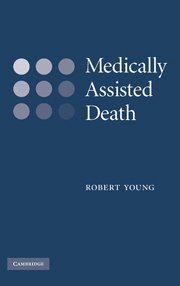Book contents
- Frontmatter
- Contents
- Acknowledgments
- 1 Introduction
- 2 A case for the legalisation of voluntary medically assisted death
- 3 Medical futility
- 4 Physician-assisted suicide
- 5 The sanctity of human life
- 6 Killing versus letting die, the doctrine of double effect, and palliative care for the dying
- 7 Professional integrity and voluntary medically assisted death
- 8 Competence and end-of-life decision making
- 9 Advance directives
- 10 Voluntary medically assisted death and slippery slope arguments
- 11 Non-voluntary euthanasia
- 12 Concluding remarks
- References
- Index of English-language legal cases
- Index of names and subjects
6 - Killing versus letting die, the doctrine of double effect, and palliative care for the dying
Published online by Cambridge University Press: 05 June 2012
- Frontmatter
- Contents
- Acknowledgments
- 1 Introduction
- 2 A case for the legalisation of voluntary medically assisted death
- 3 Medical futility
- 4 Physician-assisted suicide
- 5 The sanctity of human life
- 6 Killing versus letting die, the doctrine of double effect, and palliative care for the dying
- 7 Professional integrity and voluntary medically assisted death
- 8 Competence and end-of-life decision making
- 9 Advance directives
- 10 Voluntary medically assisted death and slippery slope arguments
- 11 Non-voluntary euthanasia
- 12 Concluding remarks
- References
- Index of English-language legal cases
- Index of names and subjects
Summary
Traditional morality considers harming others to be of great moral significance and, in consequence, incorporates constraints on certain ways of harming others. Within the tradition it has been claimed that, other things being equal, those instances of harming that result from an agent doing something are morally worse than those that result from an agent allowing something similarly harmful to occur. In this chapter I will, first, consider whether there is a morally significant distinction between doing and allowing, particularly in the context of end-of-life medical care wherein it manifests as the distinction between killing a patient and allowing a patient to die. Much of the criticism of the moral significance of this distinction has come from consequentialists, for whom minimising harm is obligatory, but it has also been criticised by those traditionalists who think a more refined approach is needed to effectively prohibit only a narrower band of harmful behaviour. Many of these latter critics think what needs to be constrained is harm that is done intentionally, rather than harm that is merely foreseen to flow from otherwise justifiable behaviour. So, my second concern in this chapter will be to consider the moral significance of the ‘doctrine of double effect’, particularly as it bears on end-of-life palliative care. According to this doctrine, it is sometimes morally permissible unintentionally to occasion harm (including, bringing about death), despite the harm being foreseen, provided there is a sufficiently grave reason, whereas to intend the harm as a means, even with equally grave reason, is prohibited.
- Type
- Chapter
- Information
- Medically Assisted Death , pp. 84 - 112Publisher: Cambridge University PressPrint publication year: 2007



